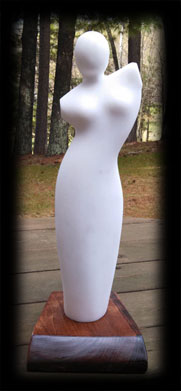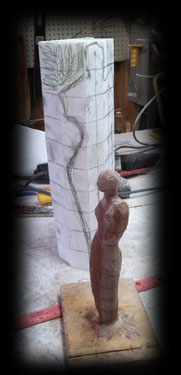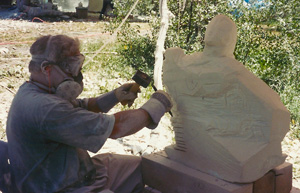For those who want to know more: additional observations for sculptors
Some common sense strategies to keep in mind.
If you carve much stone, these principles will soon become second nature.
Minimize risks— 
-
Practice safety first, second and third. If you carve stupid you are guaranteed to pay a price somewhere along the way
-
Take care of your hands—they are your major tool. Give them a break once in a while. And remember while nine fingers are better than eight, they are definitely not better than ten.
-
Use safety equipment at ALL times—breathing mask, goggles, ear protection, and proper clothes. It cost me $850 to invite an emergency room doctor to use a size 18 needle to remove a piece of marble from my eye. Yep, high priced entertainment!
-
Use leverage not lifting. Stone is heavy (about 170#lbs per cubic foot). It doesn’t take much to be unliftable.
-
Handle power tools carefully. If a blade will cut stone like butter, it will also cut other things like flesh and bones in ways too gruesome to mention here
-
Remember, the residue you are creating is not dust; it is rock grit—small sharp airborne slivers of rock!
Build energy and beauty into your sculpture 
-
Attend to form and shape. The overall movement and energy of the piece is way more important than the details of texture and stone color. Your eye will fill in details on a good form, but will flinch at seeing poor form and shape covered with accurate details.
-
Build in motion using asymmetry and tension. Perfect balance is stable and less interesting.
-
In sculpture shadow and light help determine the shape that is perceived.
-
Attend to the whole—base, pedestal, placement and lighting are as important as the sculpture itself.
-
Trust your senses. Your eyes are useful. As you walk around your work consider the lines. Look carefully from many angles. Your hands trump your eyes when considering smoothness.
If it is not absolutely smooth to the touch when you begin polishing you will only highlight the surface wobbles once you finish polishing. (Think the reflective distortion of some window glass)
-
Experiment with several different kinds of stone, wood, metal, glass, and paint.
Remember: Classic Greek and Roman sculpture was painted in bright colors!
Tips on roughing out the form to avoid major mistakes
-
Mark the outside points on the stone first and do not touch them until you are well into locating the finished form
-
Cut a bit fat—you can then add nuances of posture and motion later as needed.
-
Sit back at regular intervals and just look and dream and notice. The longer you cut without quiet reflection and re-viewing, the more likely you are to make lousy cuts you will spend hours “correcting”
-
Don’t undercut or back cut too soon. It’s tempting to cut all around and under right away so that you can see more of your form sooner. If you have fully formed the back of the head and then break off the nose, you have no stone left to move the head back. If you undercut the arm and hand first, and then break the hand off when carving it, you can no longer move it down an inch or two, because the stone is no longer available. Undercutting the jaw bone early on is the primary cause of necks that are too long.
-
Adjust your design as needed along the way. Do not be a slave to your model. Let it talk with you as you move through the steps of creating the piece. When you make a mistake simply sit down a bit longer and plan a new strategy. Serendipity often makes a visit!
“Sir, do you ever make mistakes when carving?” the lady asked the famous sculptor
“Oh no, Madame, I do not ever make mistakes. However, from time to time I have been
known to alter my design when I feel it is desirable or necessary.”
Enjoy the process—carve only what you feel deep in your heart.
-
Once you carve a specific kind of stone, you will recognize it instantly anywhere you see it.
Hey, you have lived with it for weeks and become very close friends!

Create the forms that move you profoundly. Once your sculpture is finished, it’s going to be around for a long, long time. It might just as well represent a form that energizes you.
-
If you’re not having fun, stop for a while. Life is too short to create with less than full passion. There’s no sense in carving when you are frustrated. Don’t touch the stone until it is for your own pleasure.
|

